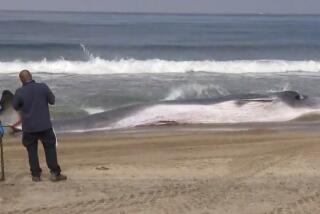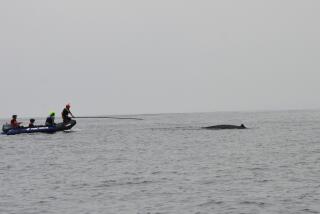DANA POINT : Spouting off for Festival of Whales
First there was the quick spout of vapor. Then the California gray whale raised a small part of its massive, barnacle-covered body out of the water and flipped its tail in the air, gathering momentum for its dive back into sea off the Laguna Beach coastline.
A circle of smooth ocean water filled with air bubbles remained in its wake, a fleeting footprint of sorts marking the mammal’s annual journey south to the warm-water lagoons of Baja California.
For whale watchers gathered on the Dana Wharf Sportfishing vessel “Sea Horse” Thursday morning, the appearance of the whale served as a fitting prelude to the 22nd annual Dana Point Festival of Whales, which starts Feb. 20. On another boat in the area, a group of schoolchildren from Riverside watched excitedly as the whales repeatedly came up for air.
While federal officials recently removed the California gray whale from the endangered species list, environmentalists say that during this local whale-watching season, people should keep in mind that the mammals are “by no means safe.”
“Just because they were taken off the endangered species list doesn’t mean they’re out of danger,” said Maris Sidenstecker II, a marine biologist and co-founder of Venice-based Save the Whales. Although the gray whales are still protected from hunting, chemical pollutants in the oceans probably pose the greatest danger to them and all marine life as well, Sidenstecker said.
“No one of us can survive if the ocean dies,” she said. “To save the whales is to save the ocean. To save the whales is part of saving ourselves.”
In the 1940s, after nearly a 100 years of intensive hunting, the number of California gray whales reached an all-time low of about 5,000. But in recent years, officials estimate the population has increased to 25,000, about the same estimated number as before intensive hunting began in the 1850s.
Maris Sidenstecker I, who along with her daughter founded the nonprofit Save the Whales in 1977, said no one is quite sure why the gray whale has flourished when other whale species have not.
With such uncertainty remaining, Save the Whales and other environmental groups have protested the action to remove the California gray whale from the endangered list, the elder Sidenstecker said.
Without the maximum protection of the endangered species list for the California gray whale, the elder Sidenstecker said she fears migratory coastal waters could be opened to more oil drilling or military testing, possible threats to the whales.
“It just has the potential to open up dangers for them,” she said. “Why remove them when they’ve just made that comeback? They’re not out of the woods yet.”
Each year, the 20- to 25-ton gray whales start their 6,000-mile migration south when the waters of the Arctic Ocean and Bering Sea turn to ice. By early December, the first of the whales reach the coastal waters of California, staying close to shore in search of the warm Mexican lagoons. The southern migration usually tapers off about mid-February, and then the trip back north begins for the whales and their newborn.
During the nine-day whale festival, Dana Point Harbor will be the center of activity as Dana Wharf Sportfishing increases its whale-watching cruises.
A host of other activities, including a street fair, a kite flying exhibition, a whale film festival, volleyball competition, five-kilometer run, golf tournament and concerts, also will be part of the festival.
More to Read
Sign up for Essential California
The most important California stories and recommendations in your inbox every morning.
You may occasionally receive promotional content from the Los Angeles Times.










